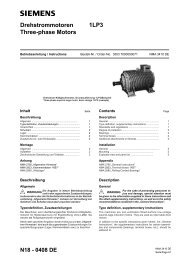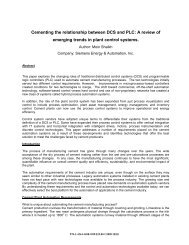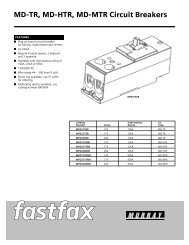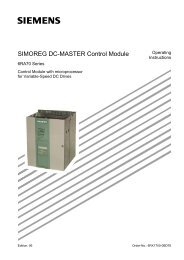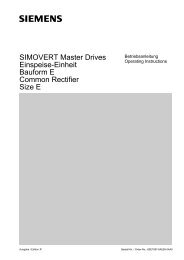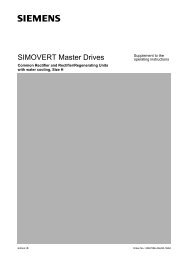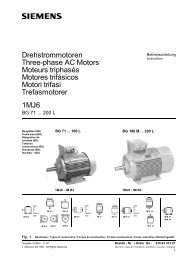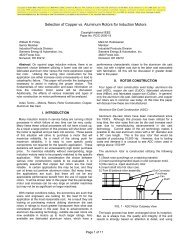WL Circuit Breakers - Siemens
WL Circuit Breakers - Siemens
WL Circuit Breakers - Siemens
You also want an ePaper? Increase the reach of your titles
YUMPU automatically turns print PDFs into web optimized ePapers that Google loves.
Communication via Ethernet Interface<br />
<strong>WL</strong> <strong>Circuit</strong> Breaker<br />
IP Addresses<br />
The partner must have a unique address<br />
so that it can be addressed in the extensive<br />
Intranet/Internet system. The IP address<br />
format is used for this purpose, which, as<br />
of Version 4, comprises four figures from<br />
0 to 255, separated by a decimal point.<br />
Example: 146.254.245.62<br />
The address is 32 bits long. Three classes<br />
have been created to enable the addresses<br />
to be structured on a world-wide basis and<br />
to ensure that the same address does not<br />
exist twice. The IP address is comprised<br />
of a small header, which describes the class,<br />
a network number, and a host number.<br />
The address of a subnetwork (Intranet, for<br />
example) is encoded in the network number.<br />
The host number is basically the unique<br />
address of a station in a network of class X<br />
and subnetwork Y.<br />
The first byte of class A IP addresses<br />
contains a number from 0 to 127: e.g.<br />
98.x.x.x. This class can support up to 128<br />
subnetworks, each with around 16 million<br />
connections. Since class A networks are<br />
very limited in number, these addresses are<br />
only available for large global companies<br />
and organizations. A Network Information<br />
Center (NIC) is responsible for assigning<br />
the classes and network numbers.<br />
Class B networks (these begin with<br />
128.x.x.x to 191.x.x.x) support up to 16,384<br />
subnetworks, each with up to 65,535<br />
stations. The majority of large companies<br />
and providers have a class B address.<br />
With around 2.1 million subnetworks, each<br />
with up to 256 stations, class C addresses<br />
are often used by smaller providers and<br />
companies with no more than 256<br />
connections in their corporate network.<br />
The IP addresses start from 192.x.x.x to<br />
223.x.x.x<br />
Subnet Mask<br />
The subnet mask provides information on<br />
the size of the subnetwork (Intranet) and<br />
its address band. In this way, each station<br />
knows whether the IP address to be<br />
addressed is located in the same<br />
subnetwork or whether it has to be<br />
addressed via a gateway.<br />
Example:<br />
IP address 1st BDA: 206.150.100.89<br />
IP address 2nd BDA: 206.150.102.32<br />
IP address gateway: 206.150.100.1<br />
IP address browser: 206.150.100.50<br />
Subnet mask: 255.255.255.0<br />
Subnet mask 255.255.255.0 means that<br />
all addresses whose first three bytes are<br />
the same as the station address are located<br />
on the line of that station. These can be<br />
addressed directly (in the example above,<br />
from the browser of the first BDA). A<br />
comparison of the address of the second<br />
BDA with the subnet mask shows that this<br />
address is not on the same line as the<br />
station. This means that the gateway must<br />
be addressed, via which the request is then<br />
forwarded to the second BDA. The subnet<br />
mask is usually 255.255.255.0.<br />
BDA IP Address<br />
The BDA must be assigned its own unique<br />
IP address that has not been used before so<br />
that it can run on the Ethernet. This address<br />
must be in the same range as the other<br />
addresses on this line.<br />
Gateway IP Address<br />
If an address that is not located in the<br />
subnetwork is addressed in the browser,<br />
the request is forwarded to the gateway.<br />
The gateway knows the location to which<br />
the request has to be forwarded on account<br />
of the configuration. The IP address of the<br />
gateway must be obtained from the<br />
network administrator.<br />
If 0.0.0.0 is set as the gateway IP address, no<br />
access to a gateway has been configured.<br />
Operation<br />
Once the addresses have been set, it should<br />
be possible to call up the BDA Plus via<br />
Ethernet. This can be checked using a test<br />
ping. To do so, enter “ping x.x.x.x” in Start ><br />
Execute (x.x.x.x is the placeholder for the IP<br />
address of the BDA to be addressed). The<br />
DOS box that then appears tells you either<br />
that a reply from the "pinged" IP address<br />
is received, or that the request has been<br />
timed out. In this case, no connection has<br />
yet been established from the BDA Plus to<br />
the target system.<br />
Note: You may have to include the IP<br />
address of the BDA Plus in the list of<br />
addresses that do not use a proxy server.<br />
The use of a proxy server is optional and<br />
depends on the network.<br />
Once a connection has been established,<br />
start the browser and enter the IP address<br />
of the BDA Plus in the address line.<br />
5/23 <strong>WL</strong> PROFIBUS/MODBUS Communication and Electronic Accessories




